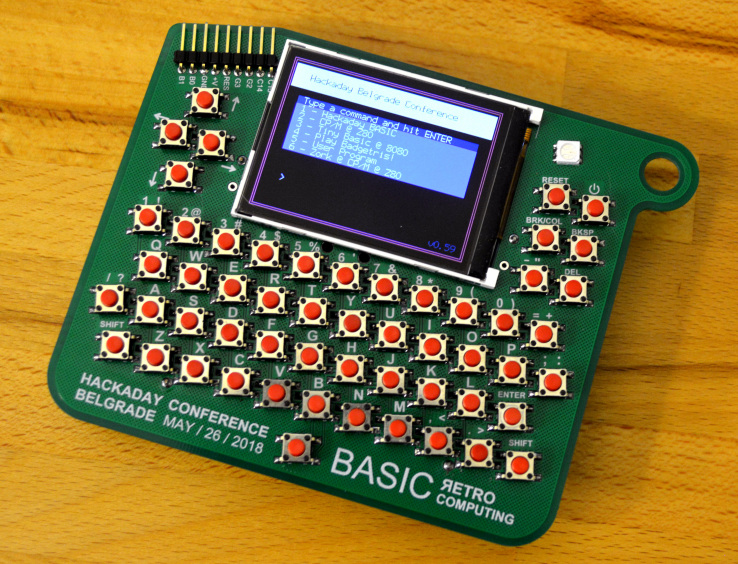A retrocomputer badge for participants of the Hackaday conference in Belgrade: dreams come true from the past

Each participant of the Hackaday conference in Belgrade will receive an unusual badge - these will be current retrocomputers. One of them is now in the hands of the author, and this is a true work of art. He is handsome, it is interesting to work and play with him, and next weekend he will have to become a platform for ... programming badges. Have you ever programmed a badge?
Small spoiler: on BASIC, under CP / M, on the emulated Z80.
')
The device really looks great. Its developer Voja Antonic is in Belgrade right now and makes sure that the manufacture of computers proceeded without interruption. Since the badges are intended for all conference participants, they need to be manufactured a lot.
Voja is able to make its development not only functional, but also aesthetic. Here in the upper left corner there is a bevel to match the comb located in the same place, and in the right corner there is a protrusion with a hole for a lace. Both lower corners are rounded. Complete all the clock buttons, soldered at an angle, and the printed conductor of the common wire, made in the form of not immediately obvious grid.
The first associations caused by the words “old computer” are a clicking keyboard, as well as a monochrome screen, green or orange. Well, the 55 clock buttons click well, and the LCD, although full-color, can be made monochrome if desired. Its resolution is 320x240, which creates the impression of a CRT with a low resolution. The computer has VT100 terminal emulation in 40 characters mode for 20 lines.
On the back of the board is a dynamic head. The sound subsystem of the machine is three-part, the sound quality is high. On the front are the RGB LED and the comb for flashing, I2C bus data exchange, as well as simply outputting several GPIOs. And the PIC32MX370F512H microcontroller, which is assisted by a two-megabyte flash memory chip, "drives" everything that happens. Many years ago it would have been a very good computer: the clock frequency was 48 MHz, 512 kilobytes of user-accessible disk space, 128 kilobytes of RAM.
The author got an early prototype of a computer, made in the amount of five copies. It has no dynamic head, a PIC24 microcontroller is used, and AA, not AAA, bays are installed. The serial version will also receive a black mask on the board and an acrylic back wall. The rest will remain unchanged. Details - on the project page .
To get such a thing is already great, but the main impression from it is, of course, software. Initially, the developer intended to make just a badge with the BASIC interpreter, but then he invented something more. He asked Jaromir Sukuba, another well-known author of Hackaday and the winner of a recent design competition, working from CR elements , to write a firmware for the badge. He agreed, and that's what happened. Let's say thanks to Jaromir for what he did and so an interesting device is even more interesting. Factor of!
It is clear that the retrocomputer desire to get, if not real vintage iron, then at least its emulator, and not the code natively executed on a modern platform. Here it is taken into account. On the computer, the Z80 emulator is running, under which the CP / M operating system is running. Once it was the most popular OS, and to prove that it really is there, the Zork game was included in the delivery set of the computer. But of course, the design possibilities are not limited to games. Using USB-TTL cable, you can exchange data with one of three 512-kilobyte drives. Provided and the connection between the two badges.
The computer is equipped and thus Tiny Basic unchanged, which works in an emulator of an earlier processor - 8080. Although it is not the basic interpreter of BASIC, it will allow you to dive into the atmosphere of the seventies and try to write an interesting program, being limited in the choice of functions and presentation ranges numbers Here is an instruction for this interpreter , dated 1979.
The same Hackaday Basic interpreter will help to take full advantage of the possibilities of iron. It allows you to save and load programs from 16 fixed files, share them via a serial interface. It includes a scripting language for writing music, there are operators to control the RGB-LED, GPIO lines on the comb. The interpreter has ample opportunities for working with the terminal emulator, allowing you to switch colors, move the cursor, update the screen and use the advanced character generator. And what else you can - look here .
All this taken together makes the design a real handheld retrocomputer. I look forward to when hundreds of such gadgets will be in the hands of conference participants, gaining a variety of programs on miniature keyboards and receiving from this incomparable joy!
And at midnight, the debriefing will begin, during which it will be known that the participants wrote the unusual for 14 hours. It turns out that people who have never programmed before have finally flashed a LED, and those who have hundreds of megabytes of demos behind them have generally replaced the device firmware with something of their own.
You can start working on your ideas now. It was recommended to future participants to bring their cables and programmers with them, because there may not be enough available ones at all. Several competitions will be held at the conference: music compositions, demos, programs in BASIC, programs for CP / M, etc. The main thing is not victory, but participation and the opportunity to show off your work - it does not matter, unprepossessing or real masterpieces - to themselves like geeks.
Source: https://habr.com/ru/post/371525/
All Articles